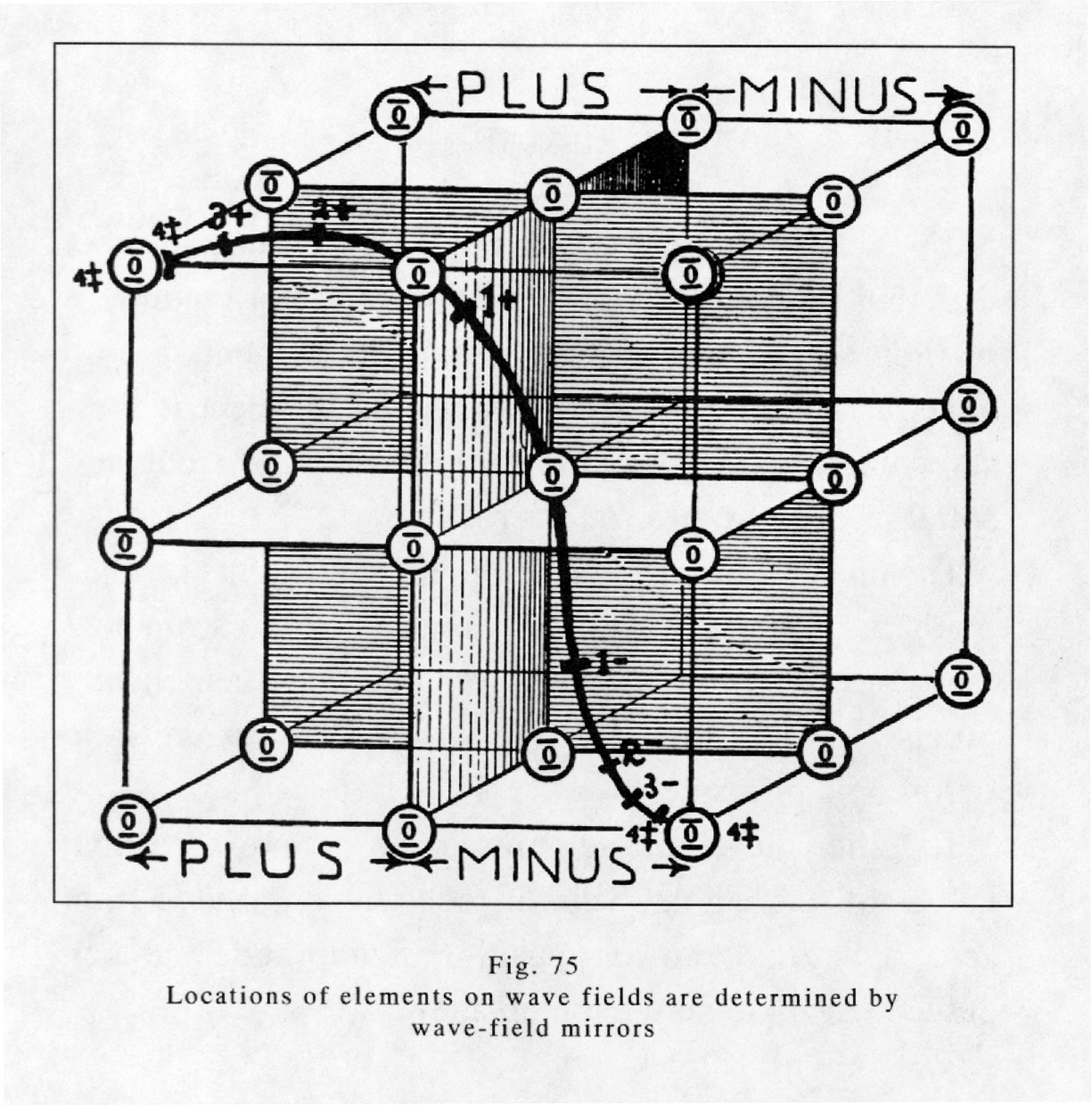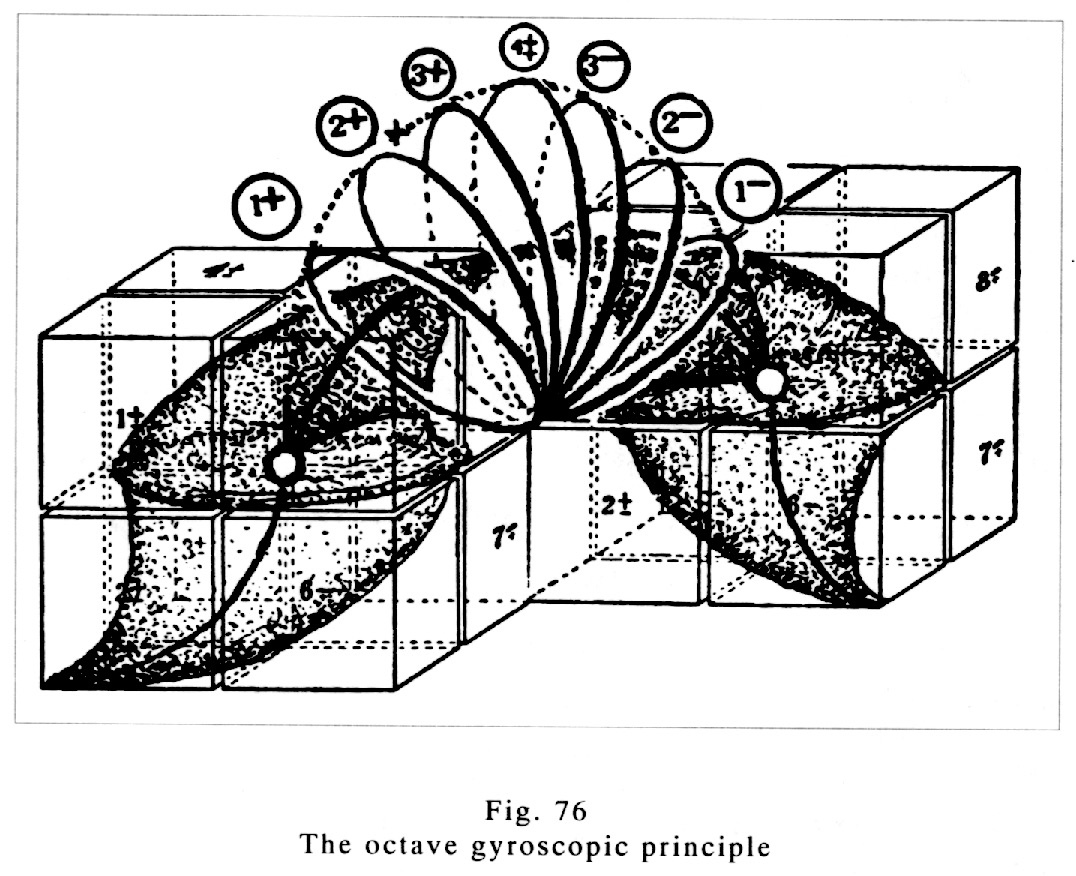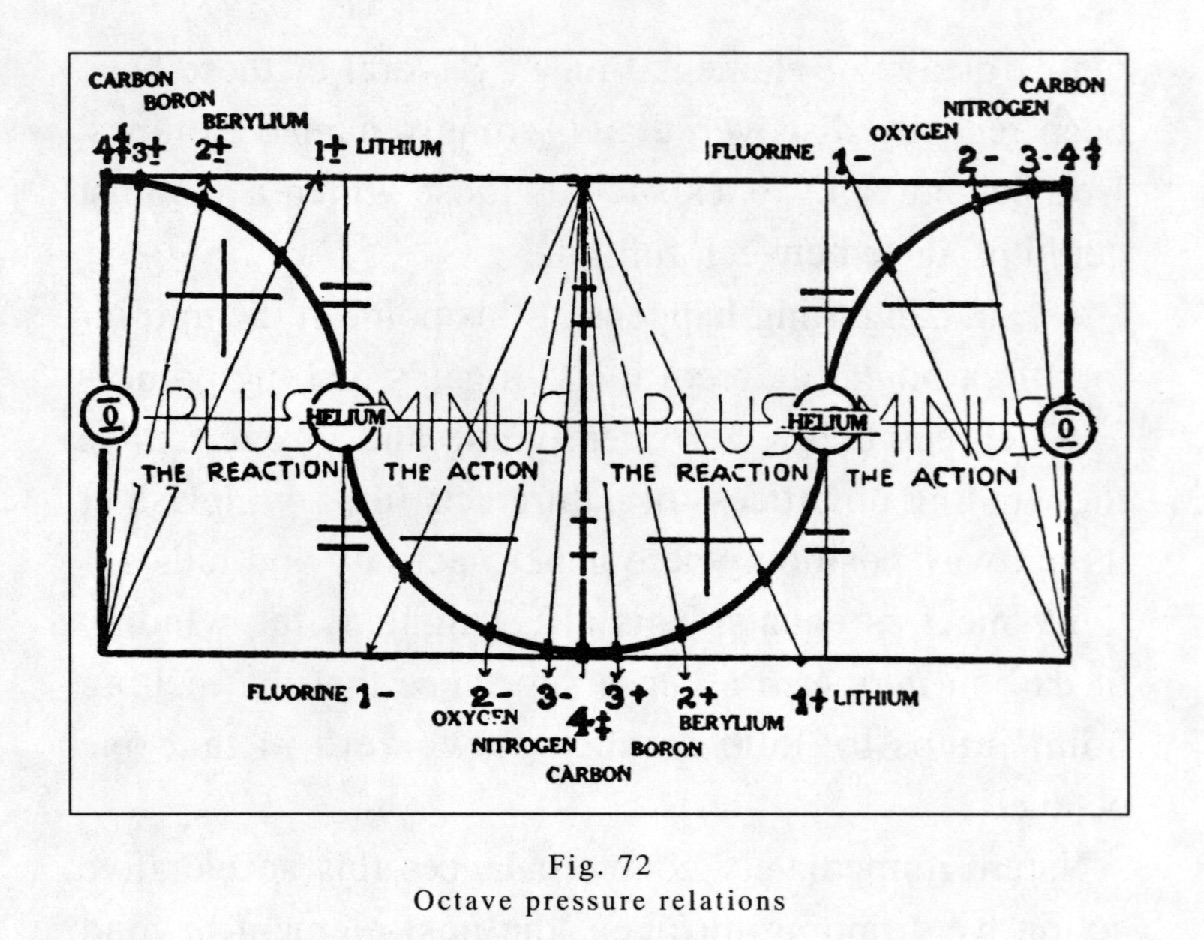The elements of matter are not different substances or different things. They are different pressure conditions of light waves. The light units of the elements are all alike but are differently conditioned by the electric pressures exerted upon them during the inward or outward spiral journey from zero to zero.
The unanswered mystery of how the elements become mathematically precise octave tones, just as musical tones or color tones of the spectrum are mathematically precise in vibration orderliness, lies in the wave field gyroscopic principle.
Together the eight elements of an octave form two halves of one whole cycle of tones which ascend from zero to the four-zero-four position of amplitude and then descend again to zero to begin anew.
This spiral journey contracts into greater pressures as it approaches wave field amplitude positions at spiral apices, and expands into lower ones on the return journey to spiral bases.
That two-way spiral journey of each half cycle extends between six mirrors of still Light which compose the wave field, and winds around a still shaft which centers the spiral. Three of these mirrors are the mirrors of action and three are the mirrors of reaction. (Fig. 75)

The three [planes] of action are the inner intersection planes of the cube and the three [planes] of reaction are the outer boundary planes of the wave field.?
All of these planes of the wave field are of zero curvature flat, but the spiral universe which is forming within those planes is curved. Curved planes of light act as two-way lenses which bend light to focal points and extend it from those focal points radially.
As the two-way spirals of forming matter extend from the wave field center in opposite directions toward wave field intersections, the six mirror planes of still light focus three points of still light upon the still shaft of each half cycle. Centers are formed at these focal points which become the one, two, three positive and negative elements of matter by rotating gyroscopically upon the wheels of light which act as equators for those borning tones.
?Multiplying and dividing pressures determine the density and volume of each succeeding element. The color spectrum records these pressures as the complete history of every element from octave to octave of the whole nine octave cycle of the elements.
Multiplying pressures of the spiral also affect the curvature of its light lenses to such an extent that the focusing positions change their mathematical ratios in conformity with the acceleration of gravity and the deceleration of radiation.
The positions of focal centers of gyroscopic wheels upon the wave shaft are thus affected as diagrammed in Fig. 76 and Fig. 72. Each element is the square of the distance to and from its succeeding one, in accordance with its direction. The direction of gravity is the inverse square, and the opposite direction is the direct square.


The volume of each succeeding element is likewise affected directly and inversely as the cube.
Six of the eight gyroscopic wheels of the whole octave are thus accounted for by geometric projection of two-way opposed lights through each other, from two sets of three mirror boundary fields. The fourth double tone is formed at the rest point where eight cube wave fields meet. This is the point of rest which is known as the center of gravity in earths or suns - where motion and curvature cease.
The completed sphere thus becomes a section of eight adjoining wave fields and revolves around that point of rest upon the wave shaft where the two half cycles of the wave meet.
For this reason the four-zero-four position is one of balance in which the yellow of orange is the dominating color of one of its two gyroscopic wheels and the yellow of green is the other, centered by white.
At the two points upon the still shaft of the turning sphere where the shaft penetrates its surface are the magnetic poles of still Light which control the balance of each sphere's turning. One of these is the north magnetic pole which controls the winding of the sphere into density by centripetal electric force, and the other is the south magnetic pole which controls its unwinding centrifugally into space.
In a sphere such as our nearly mature sun, these magnetic poles are practically upon the sun's pole of rotation, but upon ablating planets, such as our earth, the magnetic poles are removed from that pole of rotation in accordance with the measure of the earth's oblateness.
The elements of matter are miniature stellar systems. Every principle and law which applies to one applies to the other. This solar system is a gyroscopic wheel in the position which iron occupies in the elemental series. When it spirals a little further it will correspond to a carbon atom. The sun will then be a true sphere and its new planets will also be true spheres.
The gyroscopic principle accounts for that law of Nature which causes like elements to seek each other. All decomposing compounds are sorted out, element by element, gyroscopically.
The efforts of man to transmute one element into another must be governed by this principle, and not upon the theory that another substance will be obtained by "knocking out one electron." It makes no difference how many planets there are in a solar or atomic system in so far as its "substance" as an element is concerned. One or more added or subtracted would not change the element into another substance any more than one or more children would affect the nationality of their parents.
Transmutation will become simplified by observing that the plane of gyration, in relation to amplitude, and the speed of revolution of the gyroscopic wheel upon its still shaft, will alone change volume by either multiplying or dividing density.
Great possibilities in new metals lie in the proper application of this principle. [Walter Russell, The Secret of Light, pages 275-281]
